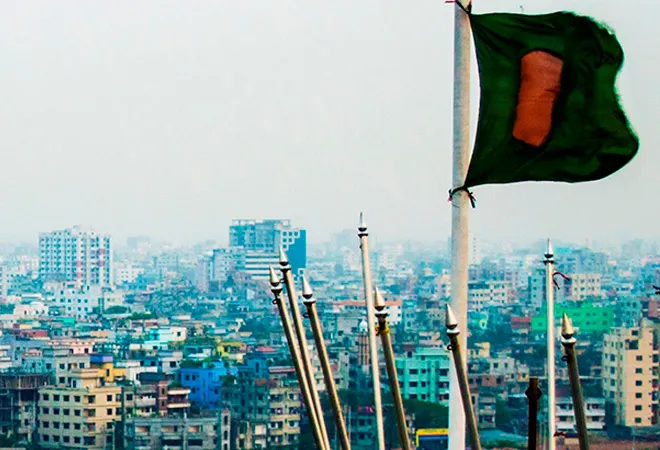Bangladeshi militant organisation, Neo-Jamaat-ul-Mujahideen Bangladesh (JMB), has once again hogged the limelight following a recent incident of knife attack on an Australian citizen by a Bangladeshi woman who travelled to Melbourne on a student visa. This incident has once again brought the global attention on the terror outfit. The accused is alleged to be a member of the militant organisation called the Neo-JMB. The group, considered to be a breakaway of the infamous banned JMB, has links with the Islamic State and came to the limelight following its involvement in the incident of the terror attack in the Holey Artisan restaurant in Dhaka in July 2016 that killed around 20 people. The activities of the group made it the face of terror for the country.
The recent incident, however, suggests that the group manages to continue its presence despite active counter-terror measures pursued by the Bangladeshi authorities. Besides, it highlights Neo-JMB’s ability to disrupt peace both at home and abroad, demanding the international community to be more vigilant about its activity. In fact, militant groups have been active in Bangladesh since the 1990s. Harkat-ul-Jihad-al-Islami (Huji), one of the first organisation formed by the veterans of Afghan jihad, went to Afghanistan to fight against the Russians in the 1980s. Huji is responsible for an early face of militancy in Bangladesh.
However, activities of the militant organisation attained global attention following the countrywide bomb blast in August 2005, when around 500 bombs were detonated in a single day by the JMB. The incident rang alarm bells. Subsequently, the group was proscribed and its top leaders — Shaykh Abdur Rahman and Siddique ul-Islam alias Bangla Bhai — were executed in 2007. Besides, a large number of its cadres were arrested due to the Government’s active counter-terror measures. For a long time, belief was that the group has been neutralised.
Bangladesh has witnessed a resurgence in terror activities since 2013, indicating regrouping of the JMB. Interestingly, substantial change has been noticed in the tactic of this group. Gradually, it has become selective in its choice of victims and mostly targets secular bloggers and writers, publishers and priests of the minority community. It is noteworthy, foreigners are often the target of new-age terror groups in Bangladesh.
As per security analysts in Bangladesh, the Neo-JMB claims its origin from the old JMB, but the two organisations are different. The organisation is one of the factions of the old JMB. To them, the JMB is divided into three parts — one is the old JMB, whose leader was Shaykh Abdur Rahman. Second faction is the Neo-JMB. And the third faction might have merged with the Ansarullah-Bangla team.
Tamim Chowdhury, a Bangladeshi-origin Canadian citizen, who was killed in 2016, was one of the founder member of the neo-JMB. Tamim was infamous for having close links with the Islamic State. After the attack on Holey Artisan restaurant in the affluent Gulshan neighbourhood of Dhaka, the neo-JMB claimed responsibility for the attack, which the Government refuted. However, the incident indicated its international links and its ability to perpetrate terror.
There is not much known about the accurate strength of the group. But unlike JMB, which mostly had madrasa educated operatives, Neo-JMB has a significant number of English educated operatives coming from affluent families of the society as its members. The group has a substantial number of women in its ranks. Many of the groups’ women members were arrested during counter-terror operations by the security agencies. In August 2016, four women members of the Neo-JMB were arrested by the security agencies from Dhaka city.
The Gulshan terror attack and the raids later by the security agencies suggest that the group has sophisticated its training module. In March 2017, during a counter-raid by the security agencies in Sylhet, the group gave a strong counter to the Army and paramilitary forces. In fact, the operation is considered to be one of the longest counter-terror operations in the history of Bangladesh until date.
With regard to the modus operandi, there is a difference between the old and the Neo-JMB. Old JMB prefers the use of bombs, while the Neo-groups have been using a variety of equipment, from sharp weapons like knife to small arms. To Bangladeshi security analysts, old and Neo-JMB have represented two different ages. The Neo-JMB is a product of cyber age and its cadres are more proficient in the use of technology.
The groups might be home-grown but its international links are well established. The recent incident of knife attack highlights the openness of this group to take up its activities beyond the boundaries of Bangladesh. Some media reports claimed the establishment of its chapter in India. The group is accused to be behind a low-intensity bomb blast in Bihar’s Bodh Gaya in January. The Indian law enforcement authorities claimed that the group had targeted Bodh Gaya to avenge Rohingya genocide in Myanmar. The activities of the Neo-JMB once proves the necessity for sustained focus on cooperation on terrorism internationally.
This commentary originally appeared in The Pioneer.
The views expressed above belong to the author(s). ORF research and analyses now available on Telegram! Click here to access our curated content — blogs, longforms and interviews.




 PREV
PREV


